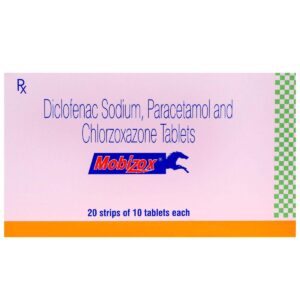PARACETAMOL (ACETAMENOPHEN) + DICLOFENAC + CHLORZOXAZONE
Paracetamol (acetamenophen): Paracetamol (also known as acetaminophen) is a commonly used over-the-counter medication used for pain relief and reducing fever. It is available in various forms, including tablets, capsules, and liquid suspensions.
Paracetamol works by inhibiting the production of certain chemicals in the brain that transmit pain signals and regulate body temperature. It also has mild anti-inflammatory effects. However, unlike nonsteroidal anti-inflammatory drugs (NSAIDs), such as ibuprofen, it does not have significant anti-inflammatory properties.
The usual dose of paracetamol for adults is 500-1000 mg every 4-6 hours, with a maximum daily dose of 4000 mg. For children, the dose is based on their weight and is usually prescribed as a suspension.
Paracetamol is commonly used for pain relief associated with headaches, toothaches, muscle aches, backaches, and menstrual cramps. It is also effective in reducing fever caused by infections or other illnesses.
While paracetamol is generally considered safe when taken as recommended, it can have side effects. Common side effects include nausea, stomach pain, and rash. In rare cases, it can cause allergic reactions, such as swelling of the face, tongue, or throat, as well as difficulty breathing. An overdose of paracetamol can cause severe liver damage, so it’s important to avoid exceeding the recommended dosage. Alcohol consumption should also be avoided when taking paracetamol to reduce the risk of liver damage. It is recommended to consult a healthcare professional before using paracetamol, especially if you have any underlying medical conditions or are taking other medications.
Diclofenac: Diclofenac is a nonsteroidal anti-inflammatory drug (NSAID) used primarily to relieve pain and reduce inflammation in various conditions such as arthritis, menstrual cramps, and postoperative pain. It belongs to the class of phenylacetic acid derivatives.
The mechanism of action of diclofenac involves inhibiting the production of prostaglandins, which are chemicals that cause pain, inflammation, and fever by promoting inflammation. By inhibiting prostaglandin synthesis, diclofenac helps to alleviate pain and reduce inflammation.
Diclofenac is available in various forms including tablets, capsules, topical gels, patches, and eye drops. The specific dose and form prescribed will depend on the condition being treated and the patient’s individual needs. The recommended dose for oral administration in adults is typically 50-100 mg taken two to three times a day. However, it is important to follow the instructions provided by the healthcare provider or those mentioned on the packaging.
As with any medication, diclofenac may cause certain side effects. Common side effects include gastrointestinal problems such as stomach pain, indigestion, nausea, and diarrhea. Some individuals may also experience dizziness, headache, rash, or elevated blood pressure. In rare cases, diclofenac can cause serious side effects such as stomach ulcers, liver or kidney problems, and allergic reactions. It is important to seek immediate medical attention if any severe or unusual side effects occur.
Diclofenac can interact with other medications, so it is essential to inform the healthcare provider about all the medications being taken to avoid any potential drug interactions.
It is important to note that diclofenac is a prescription drug and should be used strictly under the guidance of a healthcare professional. They will assess the patient’s specific condition and determine the appropriate dose and duration of treatment.
Chlorzoxazone: Chlorzoxazone is a muscle relaxant medication commonly used to relieve muscle spasms and associated pain. It is typically prescribed for conditions like musculoskeletal injuries, sprains, strains, and muscle inflammation.
The exact mechanism of action of chlorzoxazone is not fully understood. However, it is believed to work by depressing the central nervous system, specifically the spinal cord, which results in muscle relaxation and pain relief.
The usual recommended dose of chlorzoxazone for adults is 500 to 750 mg, taken three to four times per day. It should be taken with or without food, but it is generally recommended to take it with food to minimize gastrointestinal side effects.
As with any medication, chlorzoxazone can cause side effects. The common side effects include dizziness, drowsiness, headache, upset stomach, nausea, vomiting, and dry mouth. These side effects are usually mild and temporary. Rare but more serious side effects can occur, such as an allergic reaction, yellowing of the skin or eyes (jaundice), dark urine, and signs of liver problems like abdominal pain or unusual tiredness. If any severe side effects occur, it is important to seek medical attention immediately.
It is worth noting that chlorzoxazone might interact with other medications, so it is important to inform your doctor of any other medications you are taking to avoid potential drug interactions.
In summary, chlorzoxazone is a muscle relaxant used to treat muscle spasms and associated pain. It works by depressing the central nervous system. The usual dose is 500-750 mg, taken three to four times daily. Common side effects include dizziness, drowsiness, and upset stomach. Severe side effects are rare but should be reported to a doctor immediately.

